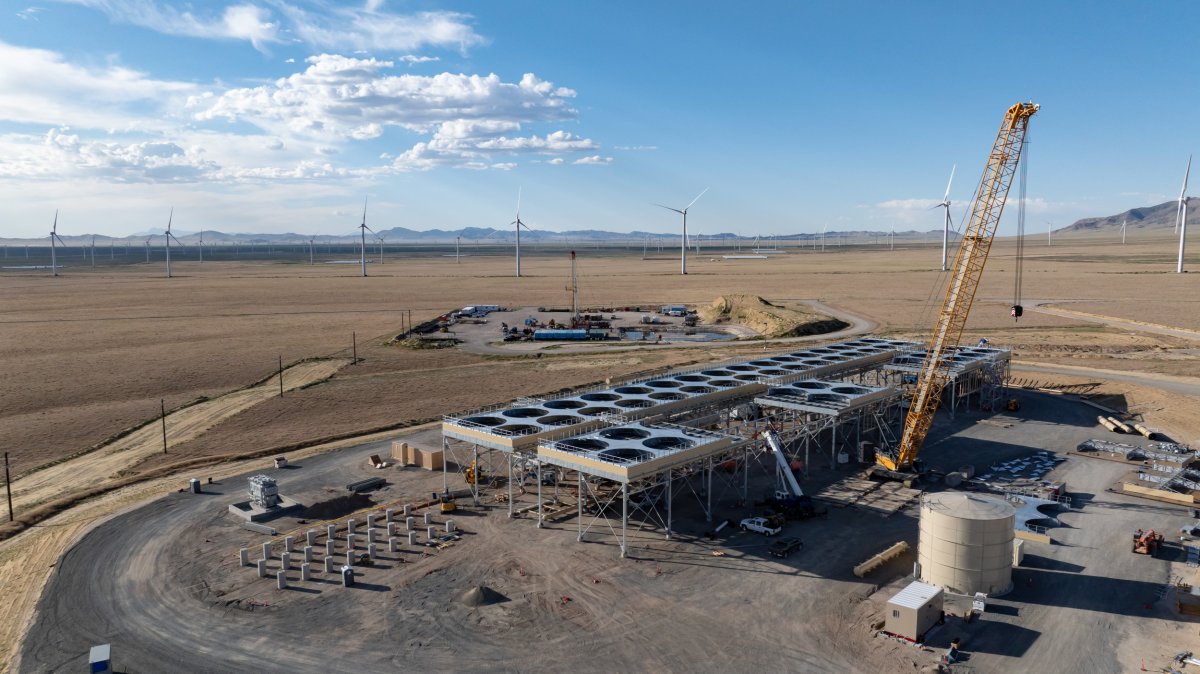Fervo uses oil drilling technology to dig deep for clean geothermal energy
June 21, 2025
The U.S. oil and gas industry sparked an energy revolution a few decades ago by thinking in a different direction—literally. Horizontal drilling, combined with hydraulic fracturing, unlocked new petroleum reserves and quickly propelled the U.S. to global leadership in oil and gas.
Fervo Energy, a company headquartered in oil capital Houston, is aiming for a similar revolution in geothermal energy by borrowing a page from the oil industry’s playbook.
“Drilling is drilling,” Fervo’s Vice President of Strategy Sarah Jewett told Newsweek. “That is kind of the ‘aha’ moment that our founders really found when they started this business.”
By using drilling technology advanced by the oil and gas industry, Fervo is drilling deeper, drilling sideways and drilling in new places to unlock new reserves of heat energy.

A member of Fervo Energy’s drilling rig crew climbs to the top of the rig in Utah. A Fervo well recently reached a depth of more than 15,000 feet, where rock is greater than 500 degrees Fahrenheit.
Courtesy of Fervo Energy
“There’s no reason why geothermal energy wells should be using older, more outdated rigs,” Jewett said.
Traditional geothermal energy relies on finding steam-bearing resources and drilling into them vertically to capture the steam heat. It requires not only hot rock but also enough permeability in the rock to allow water and heat to come together. That made geothermal power geographically limited to those places with just the right combination of factors.
Fervo is developing an enhanced geothermal system (EGS) that creates some of those conditions by making rock permeable and injecting liquid where hot rock is available.
Instead of just drilling vertical wells, the company uses horizontal drilling and hydraulic fracturing techniques to harvest naturally occurring heat.
“We are just using the heat from rock under the earth rather than steam directly to create electricity,” Jewett explained.
The U.S. Department of Energy calls EGS “the next frontier” for renewable energy. Because the technology can tap a much wider range of geothermal resources, the DOE estimates that EGS has the potential to power more than 65 million American homes and businesses.
“Really, hot rock is everywhere,” Jewett said. “It’s just a question of how deep that rock exists and how economic is it to actually get to [that] depth.”
Rock that reaches 400 to 500 degrees Fahrenheit is, generally speaking, closer to the surface in the western U.S. than in the eastern states. Fervo is focusing efforts in southwestern Utah, site of the company’s Cape Station development where the company is building three power plants.

Fervo Energy is building three power plants as part of its Cape Station development in southwestern Utah. The first is scheduled to come online in the summer of 2026.
Courtesy of Fervo Energy
Jewett said Fervo’s first power plant is scheduled to come online next summer with the first phase delivering 100 megawatts of clean power. An additional 400 megawatts of capacity is scheduled at the same site by 2028, and power purchasers include Shell Energy and Southern California Edison.
Last week the company announced that a new round of funding for the Cape Station development had secured $206 million from investors including Breakthrough Energy Catalyst, founded by Bill Gates.
In another announcement last week, Fervo shared results from one of its exploration wells that pushed the boundaries of geothermal technology. The company’s deepest well yet reached more than 15,750 feet, nearly 3 miles beneath the surface. Rock temperature at that depth is greater than 500 degrees, Jewett said, and the company is testing what happens to drill bits, casings and electronics at very high heat.
“One of our paths to innovation we call ‘boring is beautiful,'” she said. As wells reach greater depth and higher heat, companies providing parts and services test the performance of drilling equipment under increasingly harsh conditions. “That has been a really virtuous cycle of innovation between us and our partners.”
In another parallel with the oil and gas industry, Fervo had the petroleum consulting company DeGolyer & MacNaughton conduct an independent energy reserve estimate for the Cape Station project. Such reserve estimates are common when oil companies develop a new resource, but the practice is new for the geothermal industry, Jewett said.
DeGolyer and MacNaughton applied similar principles from oil analyses to evaluate the thermal energy potential at the site and concluded that Fervo’s site could yield 5 gigawatts of power. A gigawatt is enough to power a city of 750,000 homes.
With those positive developments on the technical and financial fronts, Fervo is clearly on a hot streak. But like the rest of the clean energy sector, the company is also closely watching policy developments in Washington.
Tax credits from the 2022 Inflation Reduction Act were a boon for new clean energy technology developers, not only because of the size of the credits but because the 10-year lifespan of the credits provided long-term stability to attract private investors.
The “one big beautiful” bill approved by the Republican-controlled House of Representatives late last month would end most of those clean energy credits and debate is underway on a Senate version.
“We’re fighting pretty hard to preserve tax credits because for these very early projects, it’s incredibly useful to have that that support,” Jewett said. Fervo’s first phase of development would not be affected by the changes, she said, because construction is already underway, but future projects could become more challenging.
Regardless of policy changes, however, she said she is confident that EGS power will find a market as a steady source of electricity to meet surging demand.
“Geothermal energy projects are capable of providing that ‘always on’ power,” she said. “And I think that’s why it’s become so attractive.”
Search
RECENT PRESS RELEASES
Related Post




